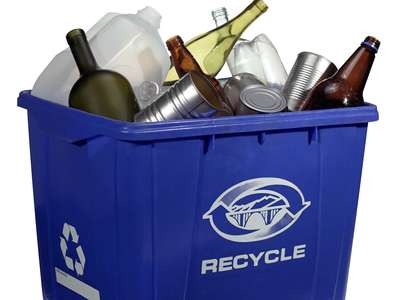RECYCLE is the process of collecting and processing used materials that would otherwise be thrown away as trash and turning them into new products.
In a series of 7 blogs, the 6 R’s of Sustainability (Review, Refuse, Reduce, Reuse, Recycle, and Rethink your Residue) are explained to give practical information about what we as a consumer can do to reduce our ecological footprint by applying these practices in our daily life.
5: RECYCLE
RECYCLE is the 5th R of Sustainability. Recycling reduces the need to grow, harvest or extract new raw materials from the Earth. That, in turn, lessens the harmful disruption and damage being done to the natural world: fewer forests cut down, rivers diverted, wild animals harmed or displaced, and less pollution of water, soil, and air.
Recyclable materials include many kinds of glass, paper, cardboard, metal, plastic, tires, textiles, batteries, and electronics. The composting and other reuse of biodegradable waste, such as food and garden waste, is also a form of recycling.
Conserving natural resources
The world’s natural resources are not infinite, and some are in very short supply. At a fundamental level:
- Recycling paper and wood saves trees and forests. Yes, you can plant new trees, but you can’t replace virgin rainforest or ancient woodlands once they’re lost.
- Recycling plastic means creating less new plastic, which is definitely a good thing, especially as it’s usually made from fossil fuel hydrocarbons.
- Recycling metals means there’s less need for risky, expensive and damaging mining and extraction of new metal ores.
- Recycling glass reduces the need to use new raw materials like sand – it sounds hard to believe, but supplies of some types of sand are starting to get low around the world.
Saving Energy
Making products from recycled materials requires less energy than making them from new raw materials. Sometimes it’s a huge difference in energy. For example:
- Producing new aluminium from old products (including recycled cans and foil) uses 95% less energy than making it from scratch. For steel it’s about a 70% energy saving.
- Making paper from pulped recycled paper uses 40% less energy than making it from virgin wood fibres.
- The amount of energy saved from recycling one glass bottle could power an old 100-watt light bulb for 4 hours and a new low-energy LED equivalent for a lot longer.
Recycling non-organic waste
If you contact a recycling facility close to your home, they can tell you what they recycle and how you can prepare the waste. Based on their information, you now know what to keep separate for recycling.
Recycling organic waste
In some areas, organic waste is picked up and composted. Farmers can also be interested in food leftovers for their pigs. But you can also recycle organic waste yourself:
- Leave grass clippings on the ground instead of bagging them when you mow your lawn. Grass clippings decompose quickly, adding nutrients to the soil.
- Separate your organic waste and learn how to compost. It’s food for your garden and it keeps organic materials out of landfills.
Your waste is your responsibility
REVIEW your current waste, REFUSE what you don’t need, REDUCE what you do need, REUSE by using reusables, RECYCLE what you can’t refuse, reduce or reuse, and RETHINK your residue waste, so you can eliminate even more waste.
Next week’s blog will be about RETHINK your Residue, the last of the R’s. Join us in a journey to take responsibility for your own waste! Read all blogs about the 6R’s here.


Recent Comments